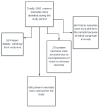Survival and associated factors of mortality of preterm neonates admitted to Felege Hiwot specialized hospital, Bahir Dar, Ethiopia
- PMID: 32922788
- PMCID: PMC7457651
- DOI: 10.1177/2050312120953646
Survival and associated factors of mortality of preterm neonates admitted to Felege Hiwot specialized hospital, Bahir Dar, Ethiopia
Abstract
Background: The complication of prematurity is the second commonest cause of under-five mortality in Ethiopia. Amhara region has the highest neonatal mortality rate in the country. There was no previous study and this study aimed to assess the survival of preterm neonates and its associated factors of preterm neonatal mortality admitted to Felege Hiwot Specialized Hospital, Bahir Dar, Ethiopia, to take necessary action to maximize survival of preterm babies in developing countries.
Methods: A retrospective cross-sectional study was conducted among 686 preterm neonates admitted in Felege Hiwot Specialized Hospital from 1 August 2017 to 30 July 2018. Kaplan-Meier survival curve was used to show the survival rate of preterm neonates and the multivariate Cox proportional hazards model was used to identify covariates of survival of preterm neonates. Those variables having a p-value less than 0.05 were statistically significant for the survival of preterm neonates.
Result: Out of 686 preterm neonates admitted from 1 August 2017 to 30 July 2018, 49.1% neonates were improved and discharged and 36.1% died. The survival rate was 0%, 19.4%, 46.7% and 75% for gestational age <28 weeks, 28-31 + 6 weeks, 32-33 + 6 weeks and 34-36 + 6 weeks, respectively. In the multivariate Cox regression model, respiratory distress syndrome, necrotizing enterocolitis, asphyxia, hospital-acquired infection, birth weight, gestational age and place of delivery were significantly associated with time to death of preterm neonates at 95% confidence level (p < 0.05).
Conclusion: The mortality rate (36.1%) of preterm neonates is unacceptably high in Felege Hiwot hospital compared to other similar hospitals in Ethiopia. More than 50% of preterm neonatal deaths can be prevented with available resources. Neonatal units with adequate and committed manpower, using a strict aseptic technique, proper follow-up, early detection and timely management of complications, are recommended to improve the survival of preterm neonates.
Keywords: Analysis; neonates; preterm; survival.
© The Author(s) 2020.
Conflict of interest statement
Declaration of conflicting interests: The author(s) declared no potential conflicts of interest with respect to the research, authorship, and/or publication of this article.
Figures






Similar articles
-
Incidence and development of validated mortality prediction model among asphyxiated neonates admitted to neonatal intensive care unit at Felege Hiwot Comprehensive Specialized Hospital, Bahir Dar, Northwest Ethiopia, 2021: retrospective follow-up study.BMC Pediatr. 2024 Mar 28;24(1):219. doi: 10.1186/s12887-024-04696-0. BMC Pediatr. 2024. PMID: 38539138 Free PMC article.
-
Predictors of Survival Among Preterm Neonates Admitted to Felege Hiwot Comprehensive Specialized Hospital, Northwest Ethiopia.Front Pediatr. 2022 Mar 10;10:800300. doi: 10.3389/fped.2022.800300. eCollection 2022. Front Pediatr. 2022. PMID: 35372165 Free PMC article.
-
Survival Status and Predictors of Mortality Among Low-Birth-Weight Neonates Admitted to the Neonatal Intensive Care Unit at Felege Hiwot Comprehensive Specialized Hospital, Bahir Dar, Ethiopia, 2020.Pediatric Health Med Ther. 2021 Sep 4;12:451-466. doi: 10.2147/PHMT.S323526. eCollection 2021. Pediatric Health Med Ther. 2021. PMID: 34512075 Free PMC article.
-
Neonatal mortality in the case of Felege Hiwot referral hospital, Bahir Dar, Amhara Regional State, North West Ethiopia 2016: a one year retrospective chart review.Ital J Pediatr. 2018 May 21;44(1):57. doi: 10.1186/s13052-018-0498-5. Ital J Pediatr. 2018. PMID: 29784060 Free PMC article.
-
Clinical outcome and risk factors of neonatal sepsis among neonates in Felege Hiwot referral Hospital, Bahir Dar, Amhara Regional State, North West Ethiopia 2016: a retrospective chart review.BMC Res Notes. 2017 Jul 11;10(1):265. doi: 10.1186/s13104-017-2573-1. BMC Res Notes. 2017. PMID: 28693597 Free PMC article.
Cited by
-
Survival status and predictors of mortality among children with severe acute malnutrition admitted to public health facilities at Hawassa City, Southern Ethiopia: a retrospective cohort study.J Health Popul Nutr. 2025 Apr 19;44(1):125. doi: 10.1186/s41043-025-00814-5. J Health Popul Nutr. 2025. PMID: 40253378 Free PMC article.
-
Nomogram to predict risk of neonatal mortality among preterm neonates admitted with sepsis at University of Gondar Comprehensive Specialized Hospital: risk prediction model development and validation.BMC Pregnancy Childbirth. 2024 Feb 15;24(1):139. doi: 10.1186/s12884-024-06306-4. BMC Pregnancy Childbirth. 2024. PMID: 38360591 Free PMC article.
-
Impact of respiratory distress syndrome and birth asphyxia exposure on the survival of preterm neonates in East Africa continent: systematic review and meta-analysis.Heliyon. 2021 Jun 8;7(6):e07256. doi: 10.1016/j.heliyon.2021.e07256. eCollection 2021 Jun. Heliyon. 2021. Retraction in: Heliyon. 2025 Feb 04;11(3):e42354. doi: 10.1016/j.heliyon.2025.e42354. PMID: 34189307 Free PMC article. Retracted.
-
Time to recovery and predictors among admitted preterm neonates in the neonatal intensive care units of public hospitals of Addis Ababa, Ethiopia, 2021.BMC Pediatr. 2024 Jul 15;24(1):452. doi: 10.1186/s12887-024-04933-6. BMC Pediatr. 2024. PMID: 39010049 Free PMC article.
-
Clinical outcome and associated factors of respiratory distress syndrome among preterm neonates admitted to the neonatal intensive care unit of Adama Hospital and Medical College.SAGE Open Med. 2022 Dec 25;10:20503121221146068. doi: 10.1177/20503121221146068. eCollection 2022. SAGE Open Med. 2022. PMID: 36600978 Free PMC article.
References
-
- International classification of diseases related health problems. 10th rev. Geneva: World Health Organization, 1992.
-
- Martin RJ, Fanaroff AA, Walsh MC. Fanaroff and Martin’s neonatal-perinatal medicine: diseases of the fetus and infant. 10th ed. Philadelphia, PA: Saunders, 2015.
-
- Kliegman R, Staton BST, Geme J, et al. Nelson textbook of pediatrics. 20th ed. Springer: Elsevier, 2015.
-
- Born too soon: The global actions report on preterm birth (Save the Children WHO), 2012, https://www.who.int/pmnch/media/news/2012/preterm_birth_report/en/
LinkOut - more resources
Full Text Sources

